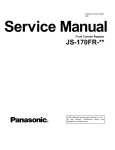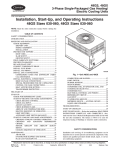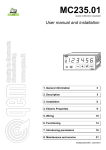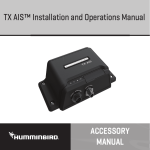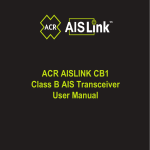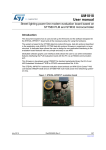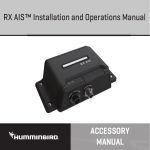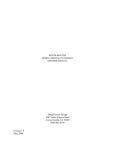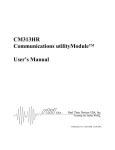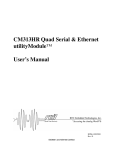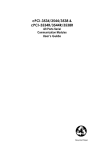Download An0044 - Eurotech
Transcript
EmbeddedDNA ® An0044 PC/104Plus CPU Module COM-1270; High speed serial ports Rev. 1.0 Nov. 2004 COPYRIGHT 1994-2004 Eurotech S.p.A. All Rights Reserved. 2 COM-1270 High speed serial ports ABOUT THIS MANUAL This application note is intended to describe the COM-1270 high speed serial ports capability. Via J. Linussio 1 33020 AMARO (UD) ITALY Phone: +39 0433 485 411 Fax: +39 0433 485 499 web: http://www.eurotech.it e-mail: [email protected] NOTICE Although all the information contained herein has been carefully verified, Eurotech S.p.A. assumes no responsibility for errors that might appear in this document, or for damage to property or persons resulting from an improper use of this manual and of the related software. Eurotech S.p.A. reserves the right to change the contents and form of this document, as well as the features and specifications of its products at any time, without notice. Trademarks and registered trademarks appearing in this document are the property of their respective owners COM-1270 High speed serial ports 3 Conventions The following table lists conventions that are used throughout this guide. Icon Notice Type Information note Warning Description Important features or instructions Information to alert you to potential damage to a program, system or device or potential personal injury (This page is intentionally left blank.) Index Conventions ................................................................................................................................................... 3 Index.................................................................................................................................................................. 5 Chapter 1 Introduction ................................................................................................................................ 6 Exar 16C554 Programmable Baud Rate Generator ...................................................................................... 6 Chapter 2 COM-1270 Serial Connectors interfaces ................................................................................. 7 J7..J14 Serial Ports in RS232 mode ....................................................................................................... 8 J7..J10 Serial ports in RS422 mode........................................................................................................ 8 J7..J10 Serial ports in RS485 mode........................................................................................................ 8 J11..J14 Serial Ports in TTL mode .......................................................................................................... 9 Serial settings .......................................................................................................................................... 9 Chapter 3 Serial port hardware architecture .......................................................................................... 10 Exar ST16C554 chipsets ............................................................................................................................. 11 Serial port frequency baud generator .......................................................................................................... 11 Glue Logic .................................................................................................................................................... 13 Serial port driver section .............................................................................................................................. 13 Chapter 4 Serial port hardware modification.......................................................................................... 14 Chapter 5 Exar ST16C554 Register List .................................................................................................. 17 Chapter 6 Pratical example....................................................................................................................... 18 6 Chapter 1 COM-1270 High speed serial ports Introduction The COM-1270 is a PC/104 formfactor board designed for communications, it supports eight channels serial ports, two CAN ports and one ethernet. The first four serial ports can operate in RS232/485 and RS422 mode or be disabled by pair, the other ports works only in RS232 mode; all the operating modes are software selectable. The serial transmission functionalityes of the board are related to the UART 16C554 chipset which is capable to support high speed baudrates. The board is configured from factory to operate in a standard baud rate range: 50, 300, 600, 1200, 2400, 4800, 9600, 19K2, 38K4, 57K6 and 115K2 software selectable. This brief application note is intended to describe how to modify and configure the COM-1270 board to operate with higher baud rates describing which are the hardware settings you’ve to realize to make the board high speed capable. Exar 16C554 Programmable Baud Rate Generator The serial functionality of the board is based on two Exar 16C554D chipsets which can support up to 921.6Kbps data rate for eight serial ports at his output pins. Single baud rate generator is provided for the transmitter and receiver, allowing independent TX/RX channel control. The programmable Baud Rate Generator is capable of accepting an input clock up to 24 MHz, as required for supporting a 1.5Mbps data rate. An external clock is connected to the XTAL1 pin to clock the internal baud rate generator for standard or 16 custom rates. The generator divides the input 16X clock by any divisor from 1 to 2 -1. The 16C554D divides the basic crystal or external clock by 16. Further division of this 16X clock provides two table rates to support low and high data rate applications using the same system design. Customized Baud Rates can be achieved by selecting the proper divisor values for the MSB and LSB sections of baud rate generator. Programming the Baud Rate Generator Registers DLM (MSB) and DLL (LSB) provides a user capability for selecting the desired final baud rate. COM-1270 High speed serial ports Chapter 2 7 COM-1270 Serial Connectors interfaces The following image show the layout of the serial ports connectors of the COM-1270 board: (RS232 only) J11 COM 5 J14 COM 6 J13 COM 7 J12 COM 8 J6 Digital I/O J15 CAN Channels J16 LEDs J2 J1 J5 AUI PC/104 BUS J4 Ethernet (RJ45) J7 COM 1 J8 COM 2 J9 COM 3 J10 COM 4 (RS232/422/485) Figure 1. J7-J12 serial connector layout Note: in the previous figure, a red square pad indicates pin 1 of each connector. 8 COM-1270 High speed serial ports J7..J14 Serial Ports in RS232 mode The following table shows the pinout of the J7..J14 serial connectors in RS232 mode. Table 1. Pin 1 2 3 4 5 6 7 8 9,10 Signal DCD DSR RX RTS TX CTS DTR RI GND J7..J14 connectors in RS232 mode. Function Data Carrier Detect Data Set Ready Receive Data Request To Send Transmit Data Clear To Send Data Terminal Ready Ring Indicator Signal Ground In/Out In In In Out Out In Out In -- DB25 DB9 8 1 6 6 3 2 4 7 2 3 5 8 20 4 22 9 7 5 J7..J10 Serial ports in RS422 mode The following table shows the pinout of the J7..J10 serial connectors with RS422 mode. Table 2. Pin 1 2 3 4 5 6 7 8 9,10 J7..J10 connectors in RS422 mode. Signal -TX -+TX --RX -+RX -GND Function Transmit Data Not connected Transmit Data Not connected Receive Data Not connected Receive Data Not connected Signal ground In/Out Out -Out -In -In --- J7..J10 Serial ports in RS485 mode The following table shows the pinout of the J7..J10 serial connectors with RS485 mode. Table 3. Pin 1 2 3 4 5 6 7 8 9,10 Signal -TX/-RX -+TX/+RX -----GND J7..J10 connectors in RS485 mode. Function Transmit/Receive Data Not connected Transmit/Receive Data Not connected Not connected Not connected Not connected Not connected Signal ground In/Out Out/In -Out/In ------- COM-1270 High speed serial ports 9 J11..J14 Serial Ports in TTL mode The following table shows the pinout of the J11,12,13,J14 serial connectors in TTL mode. Table 4. Pin 1 2 3 4 5 6 7 8 9,10 Signal DCD DSR RX RTS TX CTS DTR RI GND J11,12,13,J14 connectors in TTL mode. Function Data Carrier Detect Data Set Ready Receive Data Request To Send Transmit Data Clear To Send Data Terminal Ready Ring Indicator Signal Ground In/Out In In In Out Out In Out In -- DB25 DB9 8 1 6 6 3 2 4 7 2 3 5 8 20 4 22 9 7 5 For detailed information on how to configure the TTL mode for J11,12,13,J14 serial ports please read on. Serial settings In order to configure the serial interfaces you have to run the Setup Program. For detailed informations please refer to Chapter 5 of the COM-1270 user’s manual. 10 COM-1270 High speed serial ports Chapter 3 Serial port hardware architecture To know why hardware modification are necessary to reach high speed serial transmission it is necessary to analize the hardware architecture of the COM-1270 board. This section is intended to do this to explain the features of the board with a macro block analisys. The following block diagram show the hardware architecture of the serial ports. RS232 RS232 J7 J12 Bypass J13 J14 J11 RS232 driver or Bypass RS232 driver or Bypass RS422/485 Clock Synthetizer Exar 16C554 Exar 16C554 EEPROM Glue Logic RS232 driver or Bypass Figure 2. Block diagram The serial hardware architecture may be divided into the following main subsections: • • • • Serial chipset section (two Exar ST16C554 chipsets) Clock syntetizer Glue Logic Serial port driver section RS232 – RS422/485 J8 RS232 – RS422/485 J9 RS232 – RS422/485 J10 COM-1270 High speed serial ports 11 Exar ST16C554 chipsets The core of the serial functionality of the COM-1270 board is based on two Exar ST16C554 chipsets (quad UART with 16-byte fifo’s); each chipset provide four serial ports. For detailed information about the Exar ST16C554 chipset please refer to the technical data sheet. Baud rate of the serial transmission may be programmed by software accessing serial register; the baud rate depends on the Clock input frequency applied to the pin 26 of the chipset, the following relation describe the baudrate versus the input frequency: Baudrate = Input Frequency / ( 16 * Clock DivisorDEC) This component can reach speeds of receives trigger levels and data rates up to 1.5Mbps (with a clock reference of 24MHz). As an example we reports the following table for the derived baudrates starting from two clock reference (1.8432 MHz Clock and 7.3728 MHz Clock): Output Baud Rate Output Baud Rate (1.8432 MHz Clock) (7.3728 MHz Clock) 50 300 600 1200 2400 4800 9600 19.2k 38.4k 57.6k 115.2k 200 1200 2400 4800 9600 19.2K 38.4k 76.8k 153.6k 230.4k 460.8k Table 1. User 16 x Clock Divisor (Decimal) 2304 384 192 96 48 24 12 6 3 2 1 User 16 x Clock Divisor (HEX) 900 180 C0 60 30 18 0C 06 03 02 01 DLM Program Value DLL Program Value (HEX) 09 01 00 00 00 00 00 00 00 00 00 (HEX) 00 80 C0 60 30 18 0C 06 03 02 01 ST16C554 programming baud rates Serial port frequency baud generator To operate properly the Exar 16C554 chipset needs an external clock source, internally differents baud rates may be programmed as described in the following of the document. The primary clock source is generated by an external programmable CT2292 clock syntethizer (Ref. U3 chipset on Figure 3) which generates custom clock syntesys starting from a 14.7456MHz 50ppm reference crystal. Figure 3 show the schematic section of the clock syntetizer which generated two clocks: the CLK_SER_IN1 and CLK_SER_IN2 clock for Exar ST16554 chipsets and a clock reference for the CAN section. 12 COM-1270 High speed serial ports Figure 3. COM-1270 - CY2292 Clock synthetizer section The COM-1270 has the capability to be customized to make frequency selection for the CY2292 installing or not the components listed below: to set FSW2 to a logic zero mount R14. to set FSW1 to a logic zero mount R15. to set FSW0 to a logic zero mount R16. The following table report the CY2292 possible output frequency concerning the FSW2, FSW1 and FSW0 settings based on the 14.7456MHz: FSW2 FSW1 FSW0 0 0 0 0 1 1 1 1 0 0 1 1 0 0 1 1 0 1 0 1 0 1 0 1 Table 2. Frequency [MHz] CPUCLK 23.96160 22.11840 18.43200 16.58800 14.74560 11.05920 9.21600 7.37280 CY2292 operating frequency selection The UART frequency is derived by default from CLKB source present on U3 pin 7 output (1.8432 MHz) because the JPS2 factory default position is 1-2; the CPUCLK U3 pin 8 signal can be provided making JPS2 on 2-3 position. The R14, R15 and R16 factory default are not mounted, in this way you reach the FSW2,FSW1 and FSW0 0 logic for an output frequency of 7.37280MHz. Sometimes, may occur that some custom baud rate couldn’t be reached only with modifying the position if the FSW2..0 components and reprogramming the baud rate register; in this case you’ve to refer directly to the Eurotech S.p.A. for a custom modification changing the Y1 crystal (COM-1270 PCB has the capability to install two differents formats of crystal to allow user selecting a wide range of crystal frequencyes. The formats are HC49 or U4H SMD) with a new reference value and reprogramming the CY2292 Clock synthetizer firmware. COM-1270 High speed serial ports 13 Glue Logic The glue logic is based on a Lattice isPLSI1032E which manage various digital logic parts of the COM-1270 board, in particular for the serial section manage the activation of the serial drivers reading the EEPROM parameters stored with the SETUP program. Note that the driver selection works in pair: you can disable, enable J7 & J8, J9 & J10, J11 & J14, J13 & J12 by pair. Serial port driver section To fulfil the RS232-RS422- RS485 standard the Exar ST16C554 serial lines have to be converted to the proper phisical signal levels with specific drivers first to be applyed to the external connector. The RS232 mode is implemented inserting an ADM211 chipset; for the RS485 and RS422 a MAX483 is used. For detailed technical information regarding those chipsets please refer to the technical data sheet. Looking at the ADM211 and MAX483 data sheet you will be noticed for the following maximum serial trasmission speed listed on the next table: Driver ADM211 MAX483 Table 3. Max Data Rate 230Kbps 250 Kbps Maximum data rate Those are important informations to set the the CY2292 operating frequency selection and Exar ST16C554 baud rate selector, because if you select an higher baud rate then the driver may operate as a filter, limiting the maximum transmission speed occuring errors on the serial transmission. The following table reports the configurability of the eight serial ports of the COM-1270, and listing the high speed capability for each connector: Serial Port J7 J8 J9 J10 Enable/Disable 1 Yes Yes J11 Yes J12 J13 Yes J14 Table 4. Mode Selection RS232 High Speed limitation High Speed limitation High Speed limitation High Speed limitation High Speed compliant in TTL mode without serial driver High Speed compliant in TTL mode mode without serial driver High Speed compliant in TTL mode mode without serial driver High Speed compliant in TTL mode mode without serial driver RS422/RS485 High Speed limitation High Speed limitation High Speed limitation High Speed limitation ----- COM-1270 configuration modes Note that high speed serial communications are compliant only for J11, J12, J13 and J14 ports operating in TTL. This may be reached making the proper modifications to the hardware board. 1 The Enable/Disabile functionality and the operative mode of the serial ports may be selected by pair. 14 Chapter 4 COM-1270 High speed serial ports Serial port hardware modification This chapter is intended to give you necessary information to modify the COM-1270 default hardware settings to allow you reaching the high speed capability. If you want to exceed the RS232 serial speed of 250Kbps you have to remove the driver speed limitation, this may be done only for J12, J13, J14 and J11 connectors which have the capability to be bypassed inserting zero ohm resistors packs operating the serial ports in TTL mode; to do this hardware modification are needed as described in the following table: Serial RS232 (factory default) J11 U16 installed J12 J13 J14 TTL Remove U16, install 0Ohm CAT16 Resistor Pack RP9, RP10 Remove U17, install 0Ohm CAT16 U17 installed Resistor Pack RP15, RP16 Remove U19, install 0Ohm CAT16 U19 installed Resistor Pack RP13, RP14 Remove U18, install 0Ohm CAT16 U18 installed Resistor Pack RP11, RP12 Table 5. TTL Hardware modifications To modify the reference clock of the Exar ST16C554 you’ve to configure the R14, R15 and R16 R0805 resistors as described in the folowing table: R14 Mounted Mounted Mounted Mounted Removed Removed Removed Removed R15 R16 Frequency Mounted Mounted 23.96160 Mounted Removed 22.11840 Removed Mounted 18.43200 Removed Removed 16.58800 Mounted Mounted 14.74560 Mounted Removed 11.05920 Removed Mounted 9.21600 Removed Removed 7.37280 (factory default) Table 6. R14, R15, R16 settings COM-1270 High speed serial ports 15 The following images report the assembly drawing of the COM-1270 Rev. B board allowing you finding reference components for modification. Figure 4. Figure 5. COM-1270 Assembly top drawing COM-1270 Assembly Bottom drawing 16 COM-1270 High speed serial ports If you need to move the JPS2 solder jumper position, please note that between pin 1 and 2 there’s a wire on the PCB that must be cutted to prevent conflicts. The 2-3 JPS2 position is necessary if you want to send a custom clock to the Exar ST16C554 chipset. To prevent damages to the board all the modifications described in this chapter have to be made by technical prepared personnel. COM-1270 High speed serial ports Chapter 5 17 Exar ST16C554 Register List This chapter is dedicated to list all the Exar ST16C554 registers as a short reference for the programmer. For a detailed description of each register please refer to the component data sheet. Table 7. ST16C554 Register 18 COM-1270 High speed serial ports Chapter 6 Pratical example Suppose you want to connect an high speed RS232 device operating at 500Kb to the COM-1270. First of all you have to know that only J11, J14, J13 and J12 may be used to connect this device because it hasn’t speed limitation operating in TTL mode. Running at 500Kb need some hardware modification removing the U16, U17, U18, U19 RS232 serial drivers and install a 0 Ohm resistor packs (CAT16 package) for RP9, RP10, RP11, RP12, RP13, RP14, RP15 and RP16, this allow you to output TTL serial level. You’ve then to make the proper baud rate selection, looking at the following relation you can find the proper Clock Divisor knowing that the Input Frequency is Baudrate = Input Frequency / ( 16 * Clock DivisorDEC) The Clock DivisorDEC became: Clock DivisorDEC = Input Frequency / ( 16 * Baudrate) With the clock frequencyes listed on Table 2 you will obtain the following Clock Divisor rates: Frequency [MHz] CPUCLK 23.96160 22.11840 18.43200 16.58800 14.74560 11.05920 9.21600 7.37280 Clock DivisorDEC Calculated 2,9952 2,7648 2,304 2,0735 1,8432 1,3824 1,152 0,9216 Clock DivisorDEC Approximed 3 3 2 2 2 1 1 1 Baud Rate Approximed 499200 460800 576000 518375 460800 691200 576000 460800 Baud Rate Error 800 39200 -76000 -18375 39200 -191200 -76000 39200 COM-1270 High speed serial ports 19 Note that with an input frequency of 23.96160MHz obtained configuring the R14, R15 and R16 as listed in the following table you reach the minimum difference between the obtained and the wanted baud rate (difference of 800baud). R14 Mounted R15 Mounted R16 Mounted To select the desired input frequency you’ve to modify the R14,R15 and R16 resistor position as listed below referring to Table 2. Frequency is output from U3 pin 8 (JPS2 must be on 2-3 position – use a cutter to break the standard 1-2 default position). Some time a little difference between the wanted and obtained baudrate is tolerated from the circuitry, so firt to go on with other modifications try the configuration. If you’ve stricked limitation on the baud rate frequency you can also change the crystal reference frequency to obtain the exactly baud rate value. If you need an exactly baud rate frequency please refer to the Eurotech S.p.A.Techsupp to obtain a custom configuration. After this your serial port is ready to operate at the desired baud rate. 20 COM-1270 High speed serial ports Related Documents COM-1270 user’s manual EXAR ST16C554 QUAD UART WITH 16-BYTE FIFO.S Cypress CT2292 National Devices ADM211 Maxim MAX483 http://www.eurotech.it COM-1270 High speed serial ports 21 Technical & Sales Assistance If you have a technical question, please contact the Eurotech Customer Support Service [email protected] Old and new versions of manuals, application notes, patches, drivers and BIOS can be found at: ftp://ftp.eurotech.it/ If you have a sales question, please contact your local Eurotech Sales Representative or the Regional Sales Office for your area. Additional and latest information is available at Eurotech website, located at : http://www.eurotech.it






















